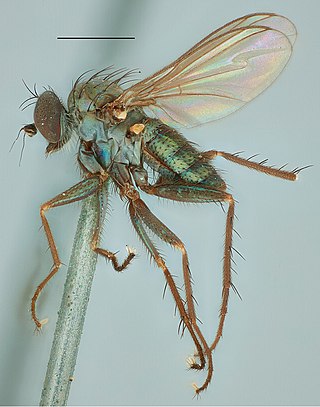
Dolichopodidae, the long-legged flies, are a large, cosmopolitan family of true flies with more than 7,000 described species in about 230 genera. The genus Dolichopus is the most speciose, with some 600 species.
Acropsilus is a genus of flies in the family Dolichopodidae. It is unplaced in the family, having been placed variously in subfamilies such as Sympycninae or Peloropeodinae. It is superficially similar to the Medeterinae.

Asyndetus is a genus of flies in the family Dolichopodidae. There are more than 100 species described for the genus, distributed worldwide.
Corindia is a genus of flies in the family Dolichopodidae. It is known from the Afrotropical and Australasian realms, and an undescribed species is also known from the Neotropical realm. The genus was first described in 1986 by Daniel J. Bickel, who originally considered it to be the sister group of the genus Thrypticus. Bickel later suggested that Corindia may represent a plesiomorphic and paraphlyetic assemblage from which Thrypticus arose.
Dytomyia is a genus of flies in the family Dolichopodidae. It is known from Australia, Madagascar and Kenya, with an undescribed species from Papua New Guinea.

Lichtwardtia is a genus of flies in the family Dolichopodidae. In a phylogenetic analysis of the subfamily Dolichopodinae by Scott E. Brooks in 2005, Lichtwardtia is considered to be a synonym of Dolichopus, but other authors retain it as a valid genus. Before this, it was considered a possible subgenus of Pterostylus by Oleg Negrobov (1979).

Medetera is a large genus of flies in the family Dolichopodidae. It includes about 350 species worldwide. The adults are commonly found resting on vertical surfaces such as tree trunks, on which they have a characteristic vertical upright stance. Because of this stance, they are sometimes known as "woodpecker flies". Medetera adults are predators of soft-bodied arthropods, while the larvae are predators of bark beetle larvae.
Mesorhaga is a genus of flies in the family Dolichopodidae.
Saccopheronta is a genus of flies in the family Dolichopodidae. It is considered a synonym of Medetera by some authors, and a valid genus by others.
Tenuopus is a genus of flies in the family Dolichopodidae. It is the only genus in the subfamily Tenuopodinae, which was created by Igor Grichanov in 2018. The genus was previously placed in the subfamily Neurigoninae, and it also shares some features of Peloropeodinae and Sciapodinae. All species are known from the Afrotropical realm.
Urodolichus is a genus of fly in the family Dolichopodidae. It is known from the Afrotropical realm, Indomalayan realm and Australasian realm. It has been placed in either Rhaphiinae or Diaphorinae, though Grichanov & Brooks (2017) consider the genus to be incertae sedis within the family Dolichopodidae.

Diaphorinae is a subfamily of flies in the family Dolichopodidae.
Cryptophleps is a genus of flies in the family Dolichopodidae.

Medeterinae is a subfamily of flies in the family Dolichopodidae.

Peloropeodinae is a subfamily of flies in the family Dolichopodidae. In some classifications, the genera of the subfamily are included in Sympycninae. According to a molecular phylogenetic analysis of the family Dolichopodidae by Germann et al. (2011), the subfamily is polyphyletic.
Medeterella is a genus of flies in the family Dolichopodidae. It contains nine species formerly included in Medetera in the M. salomonis species group. The species are found in the Afrotropical, Oriental and Australasian regions. According to Naglis and Bickel (2012), it was unwarranted to establish a separate genus for this group of species.
Demetera is a genus of flies in the family Dolichopodidae. It contains eight species formerly included in Medetera in the M. melanesiana species group. The species are found in the Afrotropical, Oriental and Australasian regions. According to Naglis and Bickel (2012), it was unwarranted to establish a separate genus for this group of species.
Afrohercostomus is a genus of flies in the family Dolichopodidae. Many of the species were formerly from "Hercostomus Group I", one of three groups of Afrotropical Hercostomus species created by Igor Grichanov in 1999.
Asioligochaetus is a disputed genus of flies in the family Dolichopodidae. It contains only one species, Asioligochaetus vlasovi, which is distributed in Central Asia. Asioligochaetus was originally proposed as a subgenus of Medetera by Oleg Negrobov in 1966. In Bickel (1985)'s revision of the Nearctic Medetera species, Asioligochaetus was treated as a synonym of Medetera, with the only species included as a member of the petulca species group. Alternatively, because of its peculiar combination of characters, Asioligochaetus was raised to genus rank by Igor Grichanov in 2009.






